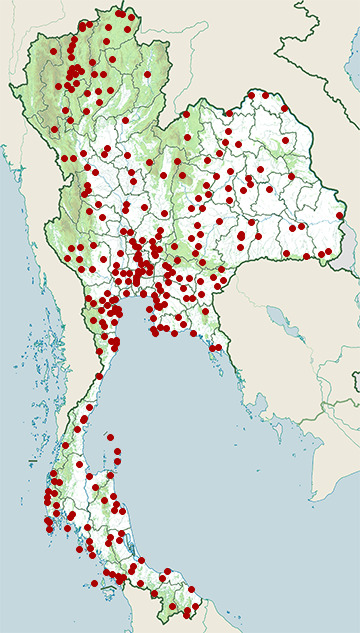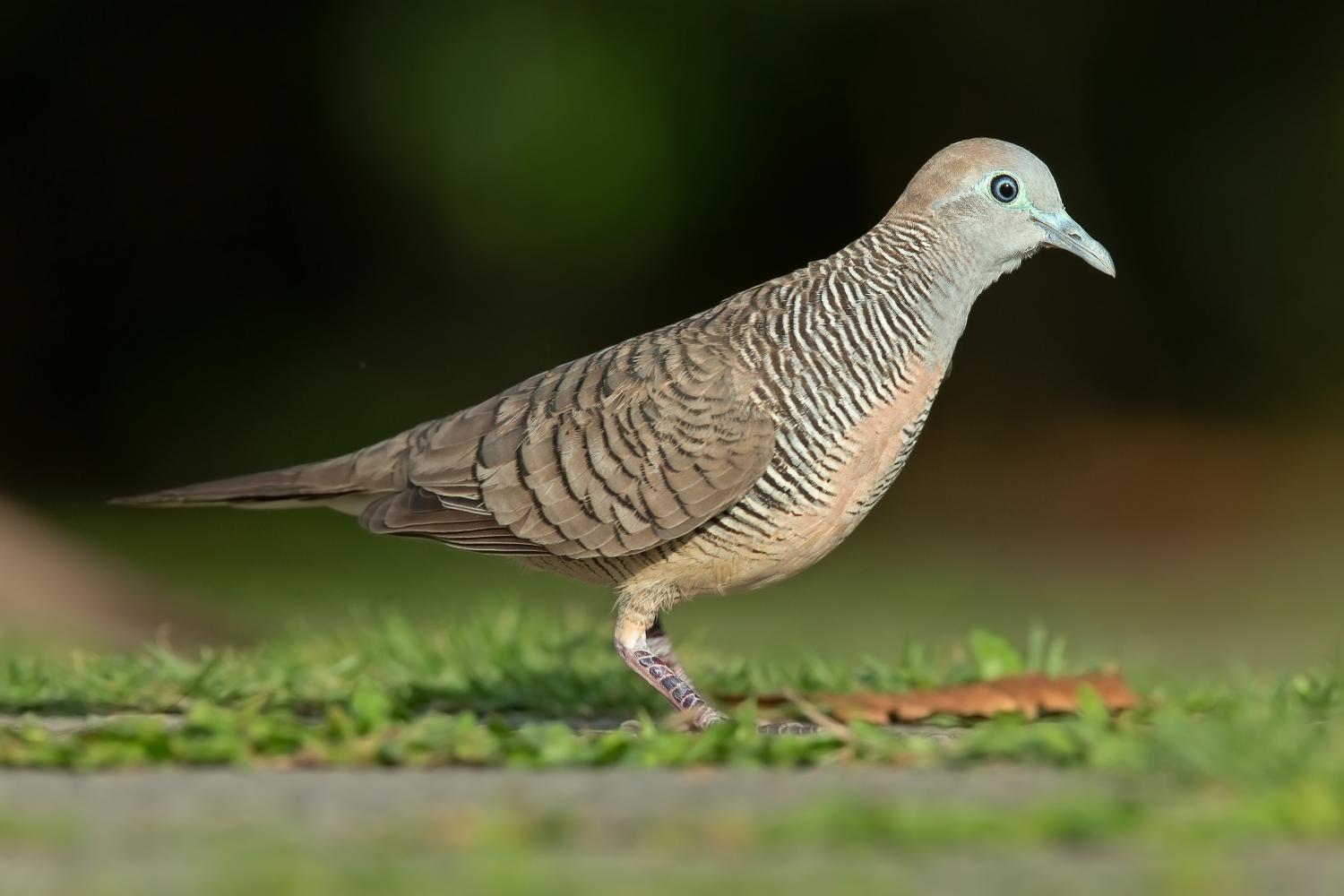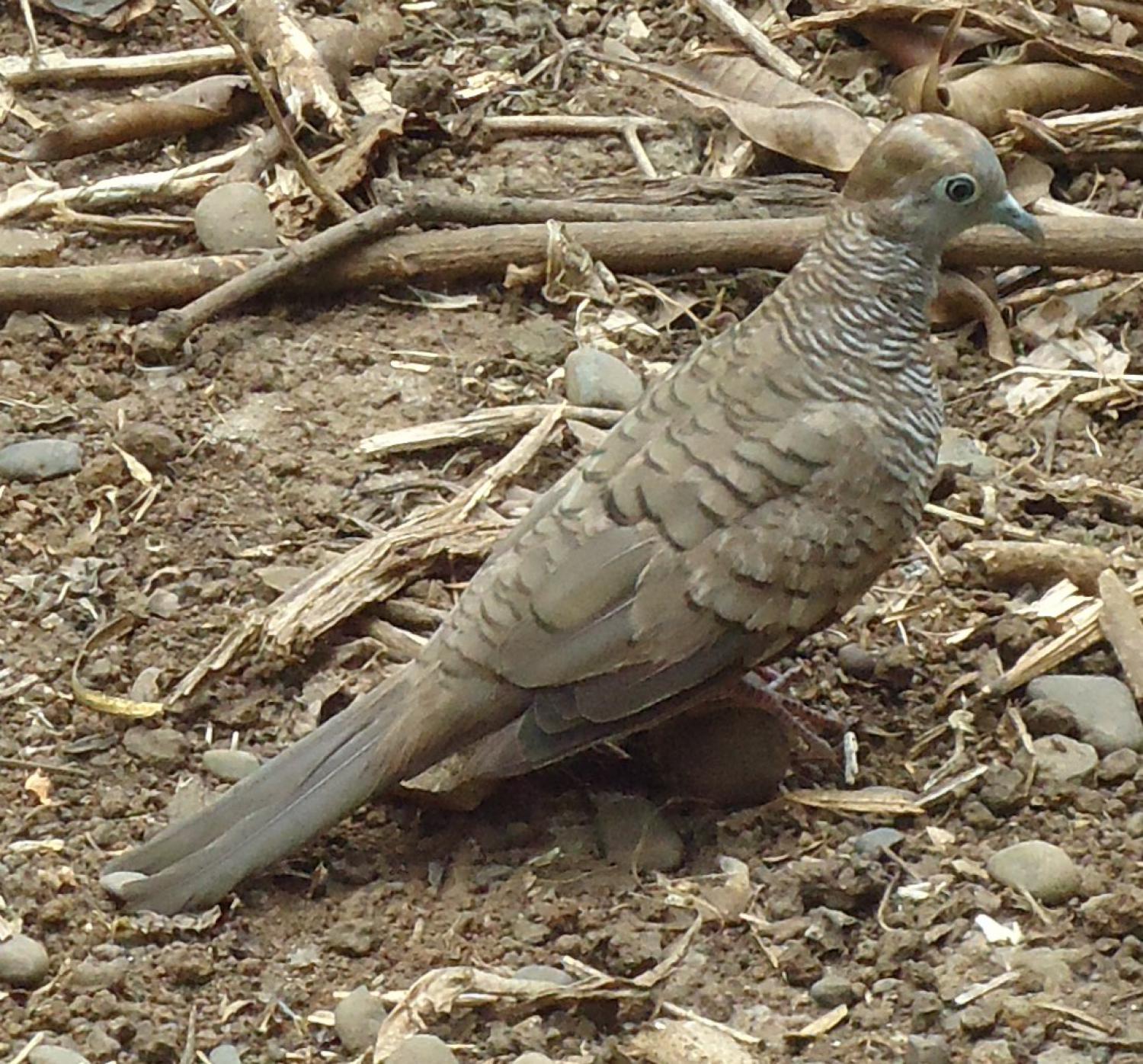Species of Thailand
Zebra dove
Geopelia striata
Carolus Linnaeus, 1766
In Thai: นกเขาชวา
The zebra dove (Geopelia striata) also known as barred ground dove, is a bird of the dove family, Columbidae, native to Southeast Asia. They are small birds with a long tail. They are predominantly brownish-grey in colour with black-and-white barring. They are known for their pleasant soft, staccato cooing calls.
Taxonomy
In 1743 the English naturalist George Edwards included a description and a picture of the zebra dove in his A Natural History of Uncommon Birds. His drawing was made from a live specimen at the home of admiral Charles Wager in Parsons Green near London. Edwards was told that the dove had been brought from the East Indies. When in 1766 the Swedish naturalist Carl Linnaeus updated his Systema Naturae for the twelfth edition, he included the zebra dove and placed it with all the other pigeons in the genus Columba. Linnaeus included a brief description, coined the binomial name Columba striata and cited Edwards's work. The specific name striata is from the Latin striatus meaning "striated". The type locality has been restricted to the island of Java in Indonesia. The species is now placed in the genus Geopelia that was introduced by the English naturalist William John Swainson in 1837. The zebra dove is monotypic: no subspecies are recognised.
The zebra dove is closely related to the peaceful dove of Australia and New Guinea and the barred dove of eastern Indonesia. These two were classified as subspecies of the zebra dove until recently and the names peaceful dove and barred dove were often applied to the whole species.
Description
The birds are small and slender with a long, narrow tail. The upperparts are brownish-grey with black-and-white barring. The underparts are pinkish with black bars on the sides of the neck, breast and belly. The face is blue-grey with bare blue skin around the eyes. There are white tips to the tail feathers. Juveniles are duller and paler than the adults. They can also have brown feathers. Zebra doves are 20-23 centimetres in length with a wingspan of 24–26 cm.
Their call is a series of soft, staccato cooing notes. In Thailand and Indonesia, the birds are popular as pets because of their calls and cooing competitions are held to find the bird with the best voice. In Indonesia this bird is called perkutut. In the Philippines they are known as batobatong katigbe ("pebbled katigbe") and kurokutok; in Malaysia this bird is called merbuk, onomatopoeic to their calls. They are also known as tukmo in Filipino, a name also given to the spotted dove (Spilopelia chinensis) and other wild doves.
Distribution and habitat
The native range of the species extends from Southern Thailand, Tenasserim, Peninsular Malaysia, and Singapore to the Indonesian islands of Sumatra and Java. It may also be native to Borneo, Bali, Lombok, Sumbawa, and the Philippine islands.
The zebra dove is popular in captivity and many populations have appeared outside its native range due to birds escaping or being deliberately released. It can now be found in central Thailand, Laos, Borneo, Sulawesi, Hawaii (introduced in 1922), Tahiti (1950), New Caledonia, the Seychelles, the Chagos Archipelago (1960), Mauritius (before 1768), Réunion, and Saint Helena.
It inhabits scrub, farmland, and open country in lowland areas and is commonly seen in parks and gardens. Trapping for the cagebird industry has led to them becoming rare in parts of Indonesia but in most parts of its range it is common. Zebra doves are among the most abundant birds in some places such as Hawaii and the Seychelles.
Breeding
In its native range the breeding season is from September to June. The males perform a courtship display where they bow and coo while raising and spreading the tail. Upon selection of a nesting site, the female will place herself there and will make guttural sounds to attract males to help build the nest. The nest is a simple platform of leaves and grass blades. It is built in a bush or tree or sometimes on the ground and sometimes on window ledges. One or two white eggs are laid and are incubated by both parents for 13 to 18 days. The young leave the nest within two weeks and can fly well after three weeks.
Feeding
The zebra dove feeds on small grass and weed seeds. They will also eat insects and other small invertebrates. They prefer to forage on bare ground, short grass or on roads, scurrying about with rodent-like movement. Unlike other doves, they forage alone, or in pairs. Their colouration camouflages them wonderfully against the ground.
This article uses material from Wikipedia released under the Creative Commons Attribution-Share-Alike Licence 3.0. Eventual photos shown in this page may or may not be from Wikipedia, please see the license details for photos in photo by-lines.
Category / Seasonal Status
Wiki listed status (concerning Thai population): Native in south, introduced to central Thailand
BCST Category: Recorded in an apparently wild state within the last 50 years
BCST Seasonal status: Resident or presumed resident
Scientific classification
- Kingdom
- Animalia
- Phylum
- Chordata
- Class
- Aves
- Order
- Columbiformes
- Family
- Columbidae
- Genus
- Geopelia
- Species
- Geopelia striata
Common names
- English:
- Barred ground dove
- Peaceful dove
- Zebra dove
- French: Columbine zébrée
- Thai: นกเขาชวา
Conservation status

Least Concern (IUCN3.1)
Photos
Please help us review the bird photos if wrong ones are used. We can be reached via our contact us page.
Range Map

- Amphawa District, Samut Songkhram
- Ao Manao-Khao Tanyong National Park
- Ao Phang-Nga National Park
- Aranyaprathet District, Sa Kaeo
- Ban Bueng District, Chonburi
- Ban Chang District, Rayong
- Ban Laem District, Phetchaburi
- Ban Lat District, Phetchaburi
- Ban Lueam District, Nakhon Ratchasima
- Ban Phai District, Khon Kaen
- Ban Pho District, Chachoengsao
- Ban Phraek District, Phra Nakhon Si Ayutthaya
- Ban Sang District, Prachinburi
- Bang Ban District, Phra Nakhon Si Ayutthaya
- Bang Kruai District, Nonthaburi
- Bang Lamung District, Chonburi
- Bang Lang National Park
- Bang Len District, Nakhon Pathom
- Bang Pa In District, Phra Nakhon Si Ayutthaya
- Bang Pahan District, Phra Nakhon Si Ayutthaya
- Bang Pakong District, Chachoengsao
- Bang Phra Non-Hunting Area
- Bang Pu Recreation Centre
- Bangkok Province
- Borabue District, Maha Sarakham
- Bueng Boraped Non-Hunting Area
- Chae Hom District, Lampang
- Chaiya District, Surat Thani
- Chaiyo District, Ang Thong
- Chaloem Phra Kiat District, Saraburi
- Chatturat District, Chaiyaphum
- Chiang Dao District, Chiang Mai
- Chiang Dao Wildlife Sanctuary
- Chiang Khan District, Loei
- Chiang Khong District, Chiang Rai
- Chiang Saen District, Chiang Rai
- Chum Ta Bong District, Nakhon Sawan
- Doi Chong National Park
- Doi Inthanon National Park
- Doi Lo District, Chiang Mai
- Doi Pha Hom Pok National Park
- Doi Saket District, Chiang Mai
- Doi Suthep - Pui National Park
- Doi Tao District, Chiang Mai
- Erawan National Park
- Fang District, Chiang Mai
- Hala-Bala Wildlife Sanctuary
- Hang Chat District, Lampang
- Hat Chao Mai National Park
- Hat Yai District, Songkhla
- Hua Hin District, Prachuap Khiri Khan
- Huai Chorakhe Mak Reservoir Non-Hunting Area
- Huai Kha Khaeng Wildlife Sanctuary
- Huai Krachao District, Kanchanaburi
- Huai Sala Wildlife Sanctuary
- Huai Talat Reservoir Non-Hunting Area
- In Buri District, Sing Buri
- Kabin Buri District, Prachinburi
- Kaeng Khoi District, Saraburi
- Kaeng Khro District, Chaiyaphum
- Kaeng Krachan District, Phetchaburi
- Kaeng Krachan National Park
- Kaeng Som Maew Queen Sirikit Forest Park
- Kamphaeng Saen District, Nakhon Pathom
- Kanthararom District, Sisaket
- Kantharawichai District, Maha Sarakham
- Kapong District, Phang Nga
- Khanom District, Nakhon Si Thammarat
- Khao Ang Rue Nai Wildlife Sanctuary
- Khao Chong
- Khao Khiao - Khao Chomphu Wildlife Sanctuary
- Khao Laem Ya - Mu Ko Samet National Park
- Khao Lak - Lam Ru National Park
- Khao Luang National Park
- Khao Nam Khang National Park
- Khao Nang Phanthurat Forest Park
- Khao Phanom Bencha National Park
- Khao Phra - Bang Khram Wildlife Sanctuary
- Khao Phra Wihan National Park
- Khao Pu - Khao Ya National Park
- Khao Sam Roi Yot National Park
- Khao Sanam Prieng Wildlife Sanctuary
- Khao Soi Dao Wildlife Sanctuary
- Khao Sok National Park
- Khao Yai National Park
- Khao Yoi District, Phetchaburi
- Khlong Hoi Khong District, Songkhla
- Khlong Lan National Park
- Khlong Luang District, Pathum Thani
- Khok Pho District, Pattani
- Khok Sung District, Sa Kaeo
- Khun Chae National Park
- Khun Tan District, Chiang Rai
- Khung Kraben Non-Hunting Area
- Khura Buri District, Phang Nga
- Klaeng District, Rayong
- Ko Lanta National Park
- Ko Libong
- Ko Samui District, Surat Thani
- Ko Sichang District, Chonburi
- Ko Tao
- Kui Buri National Park
- Kumphawapi District, Udon Thani
- Kut Thing Non-Hunting Area
- Laem Ngop District, Trat
- Laem Pak Bia
- Mae Ai District, Chiang Mai
- Mae Mo District, Lampang
- Mae Ping National Park
- Mae Rim District, Chiang Mai
- Mae Sot District, Tak
- Mae Taeng District, Chiang Mai
- Mae Tha, Lampang District, Lampang
- Mae Wong National Park
- Mu Ko Phetra National Park
- Mueang Buriram District, Buriram
- Mueang Chachoengsao District, Chachoengsao
- Mueang Chaiyaphum District, Chaiyaphum
- Mueang Chiang Mai District, Chiang Mai
- Mueang Chiang Rai District, Chiang Rai
- Mueang Chonburi District, Chonburi
- Mueang Chumphon District, Chumphon
- Mueang Kalasin District, Kalasin
- Mueang Kamphaeng Phet District, Kamphaeng Phet
- Mueang Kanchanaburi District, Kanchanaburi
- Mueang Khon Kaen District, Khon Kaen
- Mueang Krabi District, Krabi
- Mueang Lampang District, Lampang
- Mueang Lamphun District, Lamphun
- Mueang Lopburi District, Lopburi
- Mueang Maha Sarakham District, Maha Sarakham
- Mueang Nakhon Nayok District, Nakhon Nayok
- Mueang Nakhon Pathom District, Nakhon Pathom
- Mueang Nakhon Ratchasima District, Nakhon Ratchasima
- Mueang Nakhon Si Thammarat District, Nakhon Si Thammarat
- Mueang Nan District, Nan
- Mueang Nong Khai District, Nong Khai
- Mueang Nonthaburi District, Nonthaburi
- Mueang Pan District, Lampang
- Mueang Pathum Thani District, Pathum Thani
- Mueang Pattani District, Pattani
- Mueang Phang Nga District, Phang Nga
- Mueang Phatthalung District, Phatthalung
- Mueang Phayao District, Phayao
- Mueang Phetchabun District, Phetchabun
- Mueang Phetchaburi District, Phetchaburi
- Mueang Phichit District, Phichit
- Mueang Phitsanulok District, Phitsanulok
- Mueang Phuket District, Phuket
- Mueang Prachinburi District, Prachinburi
- Mueang Ratchaburi District, Ratchaburi
- Mueang Rayong District, Rayong
- Mueang Sa Kaeo District, Sa Kaeo
- Mueang Samut Sakhon District, Samut Sakhon
- Mueang Samut Songkhram District, Samut Songkhram
- Mueang Saraburi District, Saraburi
- Mueang Satun District, Satun
- Mueang Sisaket District, Sisaket
- Mueang Songkhla District, Songkhla
- Mueang Sukhothai District, Sukhothai
- Mueang Suphanburi District, Suphan Buri
- Mueang Surat Thani District, Surat Thani
- Mueang Surin District, Surin
- Mueang Tak District, Tak
- Mueang Trat District, Trat
- Mueang Udon Thani District, Udon Thani
- Mueang Uttaradit District, Uttaradit
- Na Chaluai District, Ubon Ratchathani
- Nam Nao National Park
- Nam Phong National Park
- Nam Yuen District, Ubon Ratchathani
- Namtok Sam Lan National Park
- Ngao Waterfall National Park
- Non Sang District, Nong Bua Lamphu
- Non Thai District, Nakhon Ratchasima
- Nong Bong Khai Non-Hunting Area
- Nong Han Lake
- Nong Plak Phra Ya – Khao Raya Bangsa Non-Hunting
- Nong Prue District, Kanchanaburi
- Nong Song Hong District, Khon Kaen
- Nong Suea District, Pathum Thani
- Nong Waeng Non-Hunting Area
- Nong Ya Plong District, Phetchaburi
- Nong Yai Area Development Project Under Royal Init
- Omkoi Wildlife Sanctuary
- Op Khan National Park
- Pa Sak Chonlasit Dam Non-Hunting Area
- Pa Sang District, Lamphun
- Pachee River Wildlife Sanctuary
- Pai District, Mae Hong Son
- Pak Chong District, Nakhon Ratchasima
- Pak Khat District, Bueng Kan
- Pak Kret District, Nonthaburi
- Pak Phanang District, Nakhon Si Thammarat
- Pak Phli District, Nakhon Nayok
- Pak Thale
- Pak Tho District, Ratchaburi
- Pak Thong Chai District, Nakhon Ratchasima
- Pang Sila Thong District, Kamphaeng Phet
- Pathio District, Chumphon
- Pha Daeng National Park
- Pha Nam Yoi Forest Park
- Pha Taem National Park
- Phaisali District, Nakhon Sawan
- Phan District, Chiang Rai
- Phanat Nikhom District, Chonburi
- Phatthana Nikhom District, Lopburi
- Phayuha Khiri District, Nakhon Sawan
- Phi Phi Islands
- Phimai District, Nakhon Ratchasima
- Phra Nakhon Si Ayutthaya District, Phra Nakhon Si Ayutthaya
- Phra Phrom District, Nakhon Si Thammarat
- Phu Foi Lom National Park
- Phu Khiao Wildlife Sanctuary
- Phu Langka National Park
- Phu Wiang National Park
- Phutthamonthon District, Nakhon Pathom
- Pran Buri District, Prachuap Khiri Khan
- Pran Buri Forest Park
- Ramkhamhaeng National Park
- Ratchasan District, Chachoengsao
- Sai Noi District, Nonthaburi
- Sai Yok District, Kanchanaburi
- Sai Yok National Park
- Sakaerat Environmental Research Station
- Samae San Island
- Samut Prakan Province
- San Kala Khiri National Park
- San Sai District, Chiang Mai
- Sanam Bin Reservoir Non-Hunting Area
- Sanam Chai Khet District, Chachoengsao
- Sankhaburi District, Chainat
- Sattahip District, Chonburi
- Satuek District, Buriram
- Sawi District, Chumphon
- Si Maha Phot District, Prachinburi
- Si Racha District, Chonburi
- Si Sawat District, Kanchanaburi
- Si Thep District, Phetchabun
- Sikao District, Trang
- Sirinat National Park
- Song Phi Nong District, Suphan Buri
- Sri Nakarin Dam National Park
- Sri Phang-nga National Park
- Su-ngai Kolok District, Narathiwat
- Sukhirin District, Narathiwat
- Sung Noen District, Nakhon Ratchasima
- Ta Phraya National Park
- Tai Rom Yen National Park
- Taksin Maharat National Park
- Takua Pa District, Phang Nga
- Taphan Hin District, Phichit
- Tarutao National Marine Park
- Tha Chang District, Sing Buri
- Tha Phae District, Satun
- Tha Sala District, Nakhon Si Thammarat
- Tha Takiap District, Chachoengsao
- Tha Yang District, Phetchaburi
- Thai Mueang District, Phang Nga
- Thalang District, Phuket
- Thale Ban National Park
- Thale Noi Non-Hunting Area
- Tham Pratun Non-Hunting Area
- Than Sadet - Koh Pha-Ngan National Park
- Thanyaburi District, Pathum Thani
- Thao Kosa Forest Park
- Thap Lan National Park
- Thap Sakae District, Prachuap Khiri Khan
- Thawat Buri District, Roi Et
- Thung Salaeng Luang National Park
- Wang Chan District, Rayong
- Wang Nam Yen District, Sa Kaeo
- Wang Noi District, Phra Nakhon Si Ayutthaya
- Wang Saphung District, Loei
- Wat Phai Lom & Wat Ampu Wararam Non-Hunting Area
- Wat Tham Erawan Non-Hunting Area
- Watthana Nakhon District, Sa Kaeo

